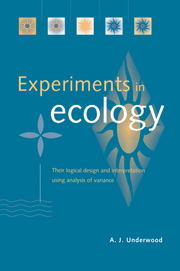Book contents
- Frontmatter
- Contents
- Acknowledgements
- 1 Introduction
- 2 A framework for investigating biological patterns and processes
- 3 Populations, frequency distributions and samples
- 4 Statistical tests of null hypotheses
- 5 Statistical tests on samples
- 6 Simple experiments comparing the means of two populations
- 7 Analysis of variance
- 8 More analysis of variance
- 9 Nested analyses of variance
- 10 Factorial experiments
- 11 Construction of any analysis from general principles
- 12 Some common and some particular experimental designs
- 13 Analyses involving relationships among variables
- 14 Conclusions: where to from here?
- References
- Author index
- Subject index
11 - Construction of any analysis from general principles
Published online by Cambridge University Press: 05 June 2012
- Frontmatter
- Contents
- Acknowledgements
- 1 Introduction
- 2 A framework for investigating biological patterns and processes
- 3 Populations, frequency distributions and samples
- 4 Statistical tests of null hypotheses
- 5 Statistical tests on samples
- 6 Simple experiments comparing the means of two populations
- 7 Analysis of variance
- 8 More analysis of variance
- 9 Nested analyses of variance
- 10 Factorial experiments
- 11 Construction of any analysis from general principles
- 12 Some common and some particular experimental designs
- 13 Analyses involving relationships among variables
- 14 Conclusions: where to from here?
- References
- Author index
- Subject index
Summary
General procedures
Having waded through the principles of nested and orthogonal, fixed and random factors, we are now in a position to consider the general principles of experimental design in relation to tests of hypotheses (Table 11.1). It is assumed that the logical basis for a test is well defined and the purpose of any experiment is very clear before any attempt is made to do it (see Chapters 2 and 4). If this is so, the appropriate controls and replicates will have been thought through properly. All of the logic having been sorted out, the steps in designing any experiment involving analysis of numerous means are the same, however complex it must be.
First, the relevant linear equation or linear model for the design must be formulated. Second, the appropriate degrees of freedom must be identified and the estimates to be obtained from mean squares defined. Finally, the formulation of sums of squares must be determined.
These steps are illustrated below for two examples. The first is an experiment about growth of plants under two different experimental factors. It has been observed that plants of a particular species grow taller in some areas than in others. It has been suggested as a model that this is due to limitations of nitrogen in the soil of some areas. Alternatively, it has been suggested (as a second model) that attacks by insects vary in intensity from place to place, causing variations in the growth of the plants.
Information
- Type
- Chapter
- Information
- Experiments in EcologyTheir Logical Design and Interpretation Using Analysis of Variance, pp. 358 - 384Publisher: Cambridge University PressPrint publication year: 1996
